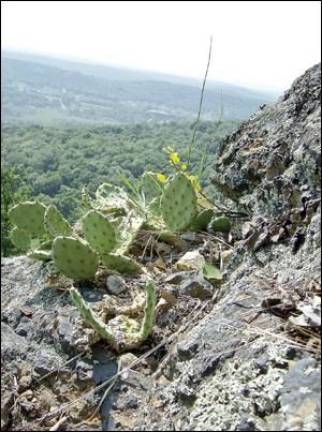Prickly pear cactus...in New York?

Everywhere we’re reminded that it’s apple season in our region. Look closer, down at the ground, and you may see other, more exotic fruit ripening among the rocks: prickly pear cactus. Unlike the domestic apple, the northern prickly pear cactus was here before Columbus, and this was the time of year when the native Lenape people harvested the sweet red fruit. It’s no easy task, however, as prickly pear have thousands of tiny, nearly microscopic hairs that penetrate the skin and cause a painful sting. This why New York colonists called it “Devil’s Apple.” For modern prickly pear seekers, the local supermarket’s your best bet. Larger stores and Latin markets carry Western and Central American prickly pears year-round. In fact, at the “Latino Market” on Main Street in historic Florida, N.Y., you can enjoy a sit-down meal of prickly-pear leaves (the spines are painstakingly removed for you), or nopales, either sautéed or as a salad, on even a tight budget. The northern prickly pear is a protected native plant here in New York and best left alone. You can, however, purchase live specimens at the larger garden centers for replanting in your garden. Deer, unfortunately, love them, and will destroy a patch in minutes. In fact, deer have destroyed many of the prickly pear colonies in our area, so remaining colonies are relegated to steep, rocky cliffs. Our (Sugar Loaf) historical society has been re-propagating prickly pear on some of our area’s steeper, rockier ridgelines, with successful results. Watch for their flowers next June, if you find yourself “bouldering” on a rock outcropping. The yellow blooms are magnificent. For now, in October and November, watch for the striking red fruit on the low plant, much as the first people here did, centuries ago. (Be mindful of private property, as well. Many of our region’s ridgelines are privately-owned, and permission should be asked of associated landowners before hiking on such property.)